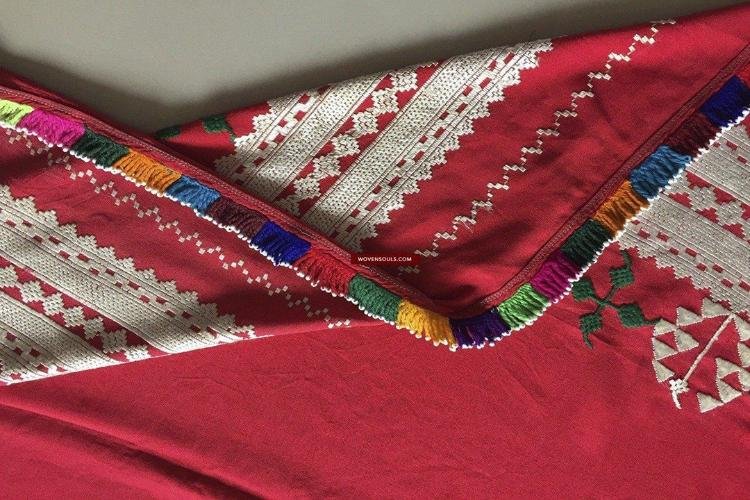What is Dorukha Embroidery?
Dorukha is a type of Indian embroidery. It’s unique for how the design of the embroidery can be seen on both sides of the cloth. It’s a blend of special colours and patterns. Kashmir Loom takes credit for this idea. It’s a mix of a kind of diamond weave with thin cashmere. This makes it a two-sided fabric with a lot of style.

( Source: Wovensoul )
How did Dorukha start? Look back to the time when cloth making was seeing a lot of progress. This was during Mughal control of Kashmir in the 16th century. People talked about Dorukha in old records like the Ain-e-Akbari. The rich and powerful people like Emperor Akbar liked it. Because of this, it became popular and in demand around the world.
As years passed, Dorukha adapted to the times. It kept up with changing colour trends and designs. The ‘boteh’ flower design still remains a favourite. But new geometrical shapes and creative styles have also been added. This is to keep up with modern tastes
Process of Dorukha Embroidery
Making Dorukha embroidery is quite precise. That reflects the perfection and adoration of an artist, who is engaged in this work. Let’s discuss the detailed steps involved in creating Dorukha embroidery:
- Fabric Choice: The first step involves selecting the right fabric. Cashmere or fine wool are often preferred because of their softness and their expertise in detailed embroidery.
- Picking Out the Design: Crafters sketch or pick out a design carefully. They also have to remember that Dorukha shows both sides. It has to look nice on both sides too.
- Thread Count: Then they resort to fine needles and threads coming in different colours as these are picked for the intricacy that comes with a design.
- Getting the Needle and Thread Ready: Then they resort to fine needles and threads coming in different colours as these are picked for the intricacy that comes with a design.
- The No-Knot Method: In Dorukha they use a method where we make patterns without tying knots. Artisans do the needlework gently. Therefore, there are no visible knots on either side of our fabric.
- Making Use of Multiple Stitches: To come up with distinct patterns and textures, various stitches are employed. Satin stitches, double satin stitches, and others are used for precision in the artwork.
- Final Touches: Once detailing is all done, it can be washed gently if need be so that its texture and appearance can be enhanced.
However, Dorukha is not only a fashionable decoration, but if properly cared for it will endure through the cold long winter months. Maintenance, however, requires careful attention: safe stowage to keep moths away and every-so-often dry-cleaning are both essential steps if Dorukha is not to be destroyed before your very eyes as a priceless heritage asset.
Yet, despite the history behind it or how plain their names sound, needlework from Dorukha continues to charm all countries’ collectors and artists. And taking history aside, at first centre stage, is the simply amazing craftsmanship involved with each minuscule part of a piece that somehow keeps it alive as a product for eternity.
Leave A Comment